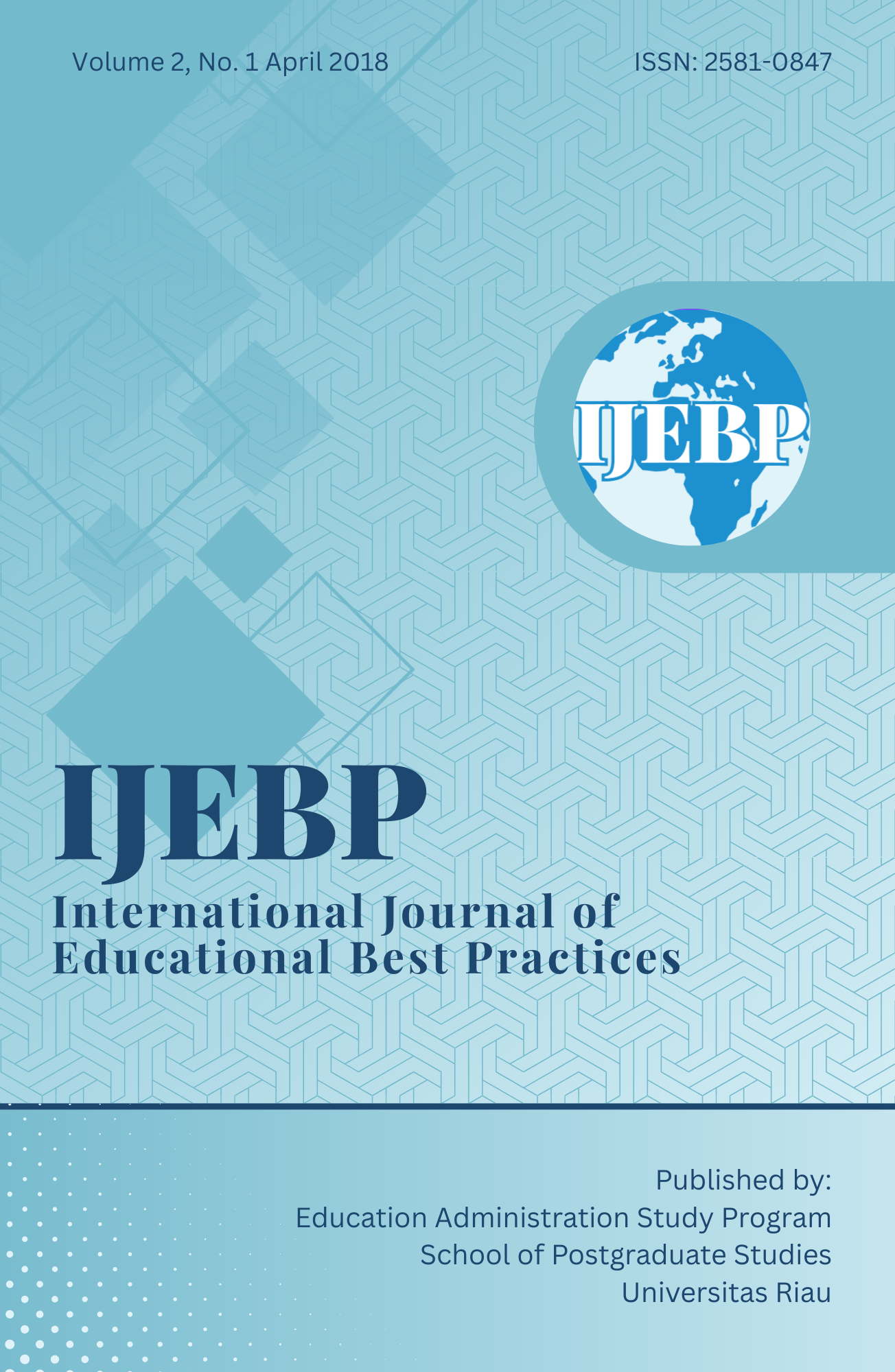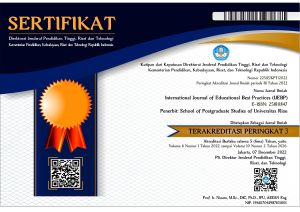BACKCHANNELS IN THE INTERACTIONS OF INDONESIAN L2 SPEAKERS OF ENGLISH IN AUSTRALIAN ACADEMIC CONTEXT
DOI:
https://doi.org/10.31258/ijebp.2.1.39-53Keywords:
backchannels, intercultural, politeness, academic discourse, IndonesianAbstract
This study investigated backchannels, short verbal responses such as yeah, employed by Indonesian L2 speakers of English in the interactions with L1 speakers of Australian English in Australian academic setting. The naturally occurring dyadic interactions were audiotaped and scrutinised in a sequential analysis of conversation analysis. The examination was aimed to scrutinise the pragmatic functions and the placement of backchannels within the sequential organisation of the interactions. The findings showed that they used backchannel responses involving non-lexical items, lexical items, and combinations of lexical and non-lexical items. Backchannel responses existed in different linguistic environments that may be culturally specific such as after you know. Backchannels were used to show attentiveness, agreement, and comprehension of the speaker’s talk. Besides, they also employed backchannels to express politeness to satisfy the supervisors’ positive face in the interactions. In this study, they appear to converge their linguistic devices to that of their supervisors.
References
Bailly, G., Elisei, F., Juphard, A., & Moreaud, O. (2016, September). Quantitative analysis of backchannels uttered by an interviewer during neuropsychological tests. In 17th Annual Conference of the International Speech Communication Association (Interspeech 2016).
Bangerter, A., & Clark, H. H. (2003). Navigating joint projects with dialogue. Cognitive Science, 27(2), 195-225. doi: 10.1207/s15516709cog2702_3
Bargiela-Chiappini, F. (2003). Face and politeness: New (insights) for old (concepts). Journal of Pragmatics, 35(10–11), 1453-1469. doi: 10.1016/S0378-2166(02)00173-X
Barron, A., & Black, E. (2015). Constructing small talk in learner-native speaker voice-based telecollaboration: A focus on topic management and backchanneling. System, 48, 112-128. doi: 10.1016/j.system.2014.09.00
Behnam, B., & Niroomand, M. (2011). An investigation of Iranian EFL learners' use of politeness strategies and power relations in disagreement across different proficiency levels. English Language Teaching, 4(4), 204-220. doi: 10.5539/elt.v4n4p204
Bell, D. C., Arnold, H., & Haddock, R. (2009). Linguistic politeness and peer tutoring. Learning Assistance Review, 14(1), 37-54.
Brown, Penelope, & Levinson, Stephen C. (1978). Universals in language usage: Politeness phenomena. In E. N. Goody (Ed.), Questions and politeness: Strategies in social interaction (pp. 56-310). Cambridge: Cambridge University Press.
Brown, Penelope, & Levinson, Stephen C. (1987). Politeness: Some universals in language usage. Cambridge: Cambridge University Press.
Clancy, P.M., Thompson, S., Suzuki, R. and Tao, H. (1996) The conversational use of reactive tokens in English, Japanese and Mandarin. Journal of Pragmatics 26, 355-387.
Clark, H. H., & Krych, M. A. (2004). Speaking while monitoring addressees for understanding. Journal of memory and language, 50(1), 62-81. doi:10.1016/j.jml.2003.08.004
Cutrone, P. (2005). A case study examining backchannels in conversations between Japanese–British dyads. Multilingua: Journal of Cross-Cultural and Interlanguage Communication, 24(3), 237-274. doi: 10.1515/mult.2005.24.3.237
Cutrone, P. (2014). A cross-cultural examination of the backchannel behavior of Japanese and Americans: Considerations for Japanese EFL learners. Intercultural Pragmatics, 11(1), 83-120. doi: 10.1515/ip-2014-0004
Deng, X. (2008). The use of listener responses in Mandarin Chinese and Australian English conversations. Pragmatics, 18(2), 303-328. doi: 10.1075/prag.18.2
Drew, Paul. (2013). Turn design. In J. Sidnell & T. Strivers (Ed.),The handbook of conversation analysis (pp. 131-149). Chichester, West Sussex, UK: Wiley Blackwell.
Fellegy, A.M. (1995). Patterns and functions of minimal response. American Speech 70(2): pp.186-199.
Félix-Brasdefer, J. C. (2008). Politeness in Mexico and the United States: A contrastive study of the realization and perception of refusals. Amsterdam, NLD: John Benjamins Publishing Company.
Fusaroli, R., Tylén, K., Garly, K., Steensig, J., Christiansen, M. H., & Dingemanse, M. (2017). Measures and mechanisms of common ground: backchannels, conversational repair, and interactive alignment in free and task-oriented social interactions. In the 39th Annual Conference of the Cognitive Science Society (CogSci 2017) (pp. 2055-2060). Cognitive Science Society.
Gardner, R. (2001). When listeners talk: Response tokens and listener stance. Amsterdam: J. Benjamins Publishing Company.
Giles, H., Bourhis, R. Y., & Taylor, D. (1977). Toward a theory of language in ethnic group relations. In H. Giles (Ed.), Language, ethnicity and intergroup relations (pp. 307- 348). London: Academic Press.
Giles, H., Coupland, N., & Coupland, J. (1991). Accomodation theory: Communication, context, and consequence. In H. Giles, J. Coupland & N. Coupland (Eds.),
Contexts of accommodation: Developments in applied sociolinguistics (pp. 1-68). United States of America: Cambridge University Press.
Gu, Y. (1990). Politeness phenomena in modern Chinese. Journal of Pragmatics, 14(2), 237- 257. doi: 10.1016/0378-2166(90)90082-o
Heinz, B. (2003). Backchannel responses as strategic responses in bilingual speakers’ conversations. Journal of Pragmatics, 35(7), 1113-1142. doi: 10.1016/S0378-2166(02)00190-X
Heritage, J. (1984). A change-of-state token and aspects of its sequential placement. In Atkinson, J.M. and Heritage, J. (Eds.) Structures of Social Interaction: Studies in Conversation Analysis. Cambridge: Cambridge University Press. pp.299-345.
Heritage, J. (2004). Conversation analysis and institutional talk: Analysing data. In D. Silverman (Ed.), Qualitative research: Theory, method and practice (2nd ed., pp. 222-245). London: Sage Publications Ltd.
Hutchby, I., & Wooffitt, R. (2008). Conversation analysis. Polity.
Hymes, Dell. (1972). Models of the interaction of language and social life. In J.J. Gumperz,
D. Hymes, (Eds.), Direction in sociolinguistics (pp. 35-71). New York: Holt, Rinehart, and Winston.
Ide, S. (1989). Formal forms and discerment: Two neglected aspects of universals of linguistic politeness. Multilingua, 8 (nos 2/3), 223-238.
Kawahara, T., Uesato, M., Yoshino, K., & Takanashi, K. (2015, January). Toward adaptive generation of backchannels for attentive listening agents. In International Workshop Series on Spoken Dialogue Systems Technology (pp. 1-10).
Kendon, A. (1967) Some functions of gaze-direction in social interaction. Acta Psycholoigia 26, 22-63. doi: 10.1016/0001-69186790005-4
King, J. (2011). Power and indirectness in business correspondence: Petitions in Colonial Louisiana Spanish. Journal of Politeness Research, 7, 259-283. doi: 10.1515/JPLR.2011.013
Kitamura, N. (2000). Adapting Brown and Levinson’s ‘politeness’ theory to the analysis of casual conversation. Paper presented at the Proceedings of ALS2k, the 2000 Conference the Australian Linguistic Society.
http://alsasn.server322.com/proceedings/als2000/kitamura.pdf
Lambertz, K. (2011). Back-channelling: The use of yeah and mm to portray engaged listenership. Griffith Working Papers in Pragmatics and Intercultural Communication,4,11-18.https://cms-dev.itc.griffith.edu.au/data/assets/ pdf_file/0005/ 384017/Lambertz-backchannelling.pdf
Matsumoto, Y. (1989). Politeness and conversational universal: Observations from Japanese. Multilingua, 8, 207-221. doi: 10.1515/mult.1989.8.2-3.207
Maynard, S. (1997). Analyzing interactional management in native/non-native English conversation: A case of listener response. IRAL- International Review of Applied Linguistics in Language Teaching, 35(1), 37-60. doi: 10.1515/iral.1997.35.1.37
Mondada, L. (2012). Video analysis and temporality of inscription within social interaction: The case of architects at work. Qualitative Research, 12(3), 304 - 333. doi: 10.1177/1468794112438149
Morgan, M. (2010). The presentation of indirectness and power in everyday life. Journal of Pragmatics, 42(2), 283-291. doi: 10.1016/j.pragma.2009.06.011
Peräkylä, A., Antaki, C., Vehviläinen, S., & Leudar, I. (2008). Analysing psychotherapy in practice. In A. Peräkylä, C. Antaki, S. Vehviläinen & I. Leudar (Eds.),
Conversation analysis and psychotherapy (pp. 5-25). New York: Cambridge University Press.
Rue, Y.-J., & Zhang, G. Q. (2008). Request strategies: A comparative study in Mandarin Chinese and Korean. Amsterdam: John Benjamins Publishing Company.
Sacks, H., Schegloff, E. A., & Jefferson, G. (1974). A simplest systematics for the organization of turn-taking for conversation. Language, 50(4), 696-735. doi: 10.2307/412243
Schegloff, E. A. (1982). Discourse as an interactional achievement: Some uses of ‘uh huh’ and other things that come between sentences. In D. Tannen (Ed.), Analysing discourse: Text and talk (pp. 71-93). Washington, D.C.: Georgetown University Press.
Stubbe, M., & Holmes, J. (1995). You know, eh and other ‘exasperating expressions’: An analysis of social and stylistic variation in the use of pragmatic devices in a sample of New Zealand English. Language & Communication, 15(1), 63-88. doi: 10.1016/0271-5309(94)00016-6
Stubbe, M. (1998). Are you listening? Cultural influences on the use of supportive verbal feedback in conversation. Journal of Pragmatics, 29(3), 257-289. doi: http://dx.doi.org/10.1016/S0378-2166(97)00042-8
Suprapto, A. A. (2012). Perilaku backchannel penutur Indonesia terhadap aizuchi dalam komunikasi verbal bahasa Jepang [Backchannel behaviour of Indonesian L2 speakers toward aizuchi in verbal communication using Japanese]. Universitas Pendidikan Indonesia.
Svennevig, J. (1999). Getting acquainted in conversation: A study of initial interactions. Amsterdam: John Benjamins Publishing Company.
Tao, H., & Thompson, S. A. (1991). English backchannels in Mandarin conversations: A case study of superstratum pragmatic ‘interference’. Journal of Pragmatics, 16(3), 209-223. doi: 10.1016/0378-2166(91)90093-D
Tolins, J., & Fox Tree, J. E. (2016). Overhearers use addressee backchannels in dialog comprehension. Cognitive science, 40(6),1412-1434.doi: 10.1111/cogs.12278
Tolins, J., & Tree, J. E. F. (2014). Addressee backchannels steer narrative development. Journal of Pragmatics, 70, 2014.06.006-152-164.doi:10.1016/j.pragma.
White, R. (1997). Backchannelling, repair, pausing, and private speech. Applied Linguistics, 18(3), 314-344. doi: 10.1093/applin/18.3.314
White, S. (1989). Backchannels across cultures: A study of Americans and Japanese. Language in Society, 18(1), 59-76. doi: 10.2307/4168001
Włodarczak, M., & Heldner, M. (2015). Respiratory properties of backchannels in spontaneous multiparty conversation. In 18th International Congress of Phonetic Sciences, Glasgow, Scotland, UK, August 10-14, 2015. University of Glasgow.
Yamaguchi, T., Inoue, K., Yoshino, K., Takanashi, K., Ward, N. G., & Kawahara, T. (2016, January). Analysis and prediction of morphological patterns of backchannels for attentive listening agents. In Proc. 7th International Workshop on Spoken Dialogue Systems (pp. 1-12).
Yazdfazeli, M., & Motallebzadeh, K. (2014). Explicit back-channel strategy training and speaking skill: Does gender matter? International Journal of Multidisciplinary and Current research, 2(sept/Oct 2014), 919-924.





